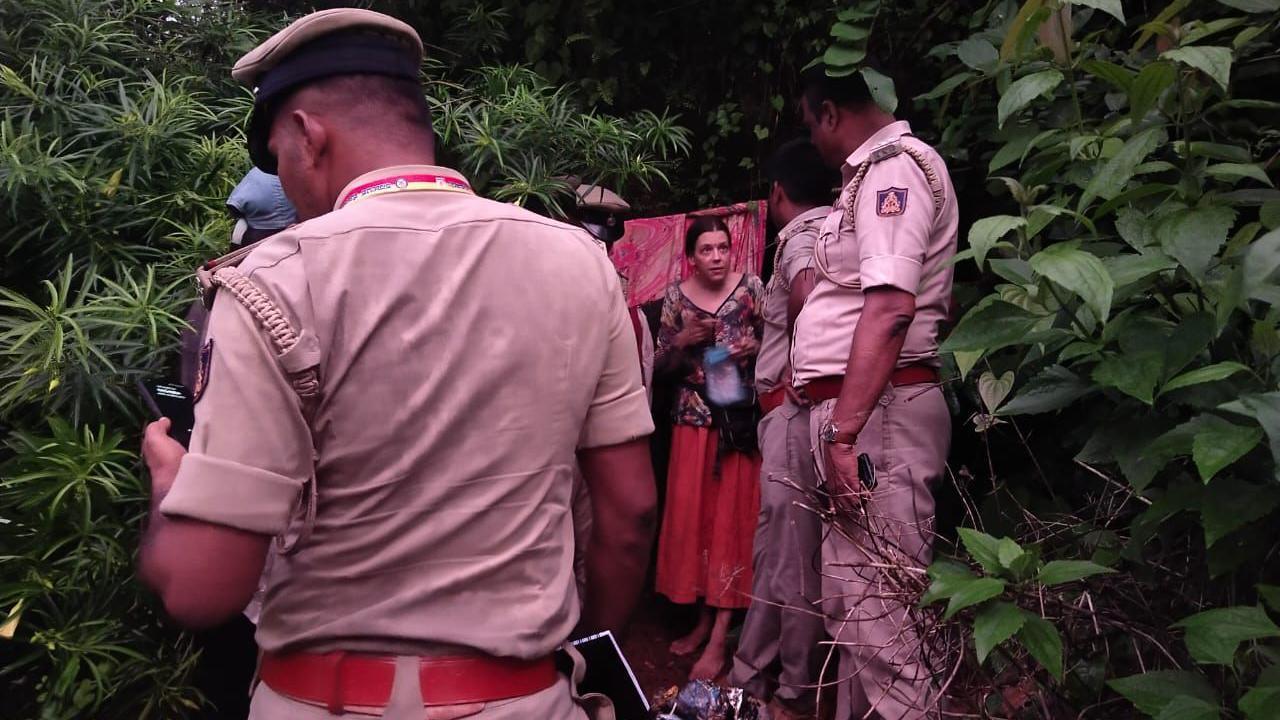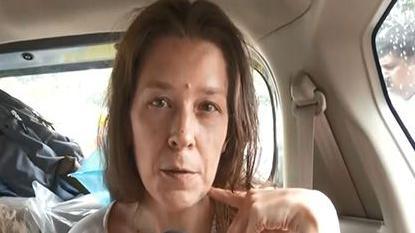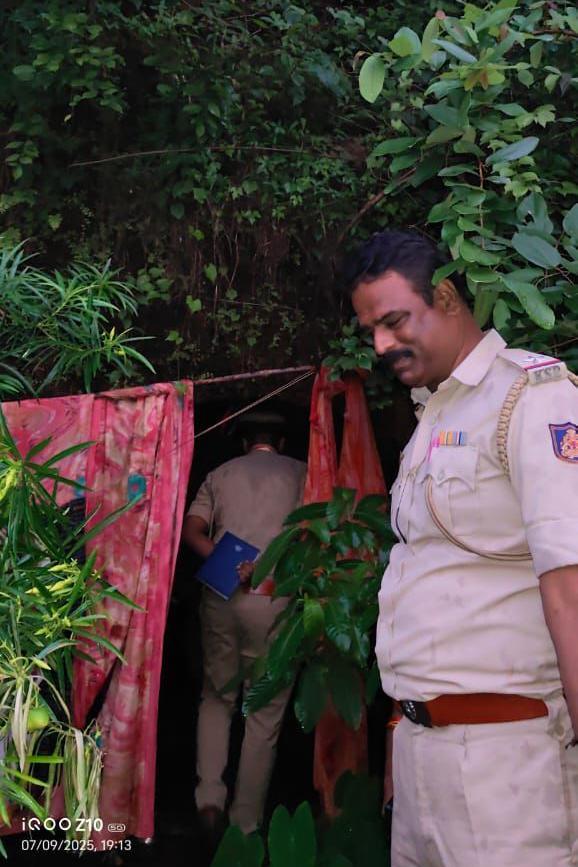Mystery surrounds Russian mum and children found in Indian cave

Kutina has defended her lifestyle saying she and her children were happy living in the cave
- Published
Police in India are trying to piece together the story of a Russian woman who was found living in a cave in the southern state of Karnataka with her two young daughters.
Nina Kutina was rescued on 9 July by policemen who were on a routine patrol near Ramteertha hills in the Gokarna forest, which borders the tourist paradise of Goa.
Authorities say the 40-year-old and her daughters - six and five years old - do not have valid documents to stay in India. They have been lodged in a detention centre for foreigners near Bengaluru, the state capital, and will be deported soon.
Kutina has defended her lifestyle in two video interviews to Indian news agency ANI, saying she and her children were happy living in the cave and that "nature gives good health".
But even a week after they were found, there is very little clarity on how the woman and her children came to be in a forest infested with snakes and wild animals; how long they had been living there and who they really are.
Police stumble on the cave dwelling
"The area is popular with tourists, especially foreigners. But it has a lot of snakes and it's prone to landslides, especially during the rainy season. To ensure the safety of tourists, we started patrolling the forests last year," M Narayana, superintendent of police for Uttara Kannada district, told the BBC.
A second policeman who cannot be named and was part of the patrol party that stumbled on the cave dwelling said they walked down a steep hill to investigate when they saw bright clothes that had been hung outdoors to dry.
When they got closer to the cave - the entrance to which had been curtained off with brightly coloured saris - "a little blonde girl came running out". When the shocked policemen followed her inside, they found Nina Kutina and the other child.
Their possessions were meagre - plastic mats, clothes, packets of instant noodles and some other grocery items - and the cave was leaking.
Videos shot by the police at the cave dwelling which the BBC has seen, show the children dressed in colourful Indian clothes, smiling into the camera.
"The woman and her children appeared quite comfortable in the place," Mr Narayana said. "It took us some time to convince her that it was dangerous to live there," he added.
Police said when they told her that the cave was unsafe because of the presence of snakes and wild animals in the forest, she told them: "Animals and snakes are our friends. Humans are dangerous."
Kutina and her daughters were taken to a hospital for a check-up after their rescue and were certified to be medically fit.
Who is Nina Kutina?

Nina Kutina has said she was born in Russia but hasn't lived there for 15 years
An official in India's Foreigners Regional Registration Office (FRRO) has told the BBC that she's Russian and that she will be repatriated once the formalities are completed.
He says they have reached out to the Russian consulate in Chennai - the BBC has also written to the Russian embassy in Delhi but they are yet to respond.
In video interviews with India's ANI and PTI news agencies, Kutina said she was born in Russia but hadn't lived there for 15 years and travelled to "a lot of countries, Costa Rica, Malaysia, Bali, Thailand, Nepal, Ukraine".
In her interviews with both agencies, Kutina said she had four children between the ages of 20 and 5 years. She talked about the eldest - "my big son" - who died in a road accident in Goa last year.
Officials say her second son is 11-years-old and is in Russia - and that they have shared the information with the consulate.
On Tuesday night, the FRRO said they had tracked down the father of the girls - Dror Goldstein - and that he was an Israeli businessman. They said he was in India at the moment and that they met him and were trying to persuade him to pay for Kutina and her daughters' repatriation.
On Wednesday, Goldstein told India's NDTV channel, external that Kutina had left Goa without informing him and that he had lodged a missing complaint with the police there.
He said he wanted joint custody of his daughters and would do everything to prevent the government from sending them to Russia.
When did she come to Gokarna?
There is no clarity on how and when Kutina and her daughters reached the forest in Karnataka.
Police said she told them that they had been living in the cave for a week. They added that she had bought some vegetables and groceries, including a popular brand of instant noodles, from a local store, a week ago.
They said she told them that she arrived in Karnataka from Goa where she also claimed to have lived in a cave. She also said that one of her daughters was born in a Goa cave.
In her interview to PTI on Wednesday, she complained about the detention centre where she's been lodged with her daughters saying "it is like jail".
"We lived in a very good place. But now we cannot be alone. We cannot go outside. Here it's very dirty, and there's not enough food," she added.
It's not clear when and how Kutina came to India.
Police say she told them she had lost her passport, but they were able to find an older expired passport among her belongings which showed that she had come to India on a business visa which was valid from 18 October 2016 to 17 April 2017.
But she overstayed, was caught a year later, and the Goa office of the FRRO issued her "an exit permit" to leave India. According to immigration stamps in her passport, she entered Nepal on 19 April 2018 and exited three months later.
It's not clear where she went after that, but Kutina told ANI that overall she had "travelled to at least 20 countries" - at least "four of them since leaving India in 2018".
It's also not clear when she returned to India next, although some reports say she's been back since February 2020. She told PTI that she returned because "we really love India".
Kutina admitted that her visa expired a few months back. "We don't have our visa, valid visa, our visa finished," she said, adding that the lapse happened because she was grieving for her dead son and couldn't think of anything else.
Why was Kutina living in a cave?

The entrance to the cave where Kutina was living with her daughters had been curtained off with brightly coloured saris
After an idol of Panduranga Vittala, a form of Hindu god Krishna, was found in her cave dwelling, it was reported that she had gone there to do meditation and for spiritual reasons.
But in her interview to ANI, she rejected the narrative. "It is not about spiritually. We just like nature because it gives us health... it's very big health, it's not like you live in a home."
She added she had "big experience to stay in natural, in jungle" and insisted that her daughters were happy and healthy there. The cave she had chosen was "very big and beautiful" and it was "very close to a village" so she could buy food and other necessities.
"We were not dying, and I did not bring my children, my daughters, to die in jungle. They were very happy, they swam in the waterfall, they had a very good place for sleeping, a lot of lessons in art making, we made from clay, we painted, we ate good, I was cooking very good and tasty food," she told ANI.
Kutina also rejected suggestions that living in the forest exposed her children to danger.
"For all the time we lived there, yes we saw a few snakes," she said, but added that it was similar to people reporting finding snakes in their homes, kitchens or toilets.